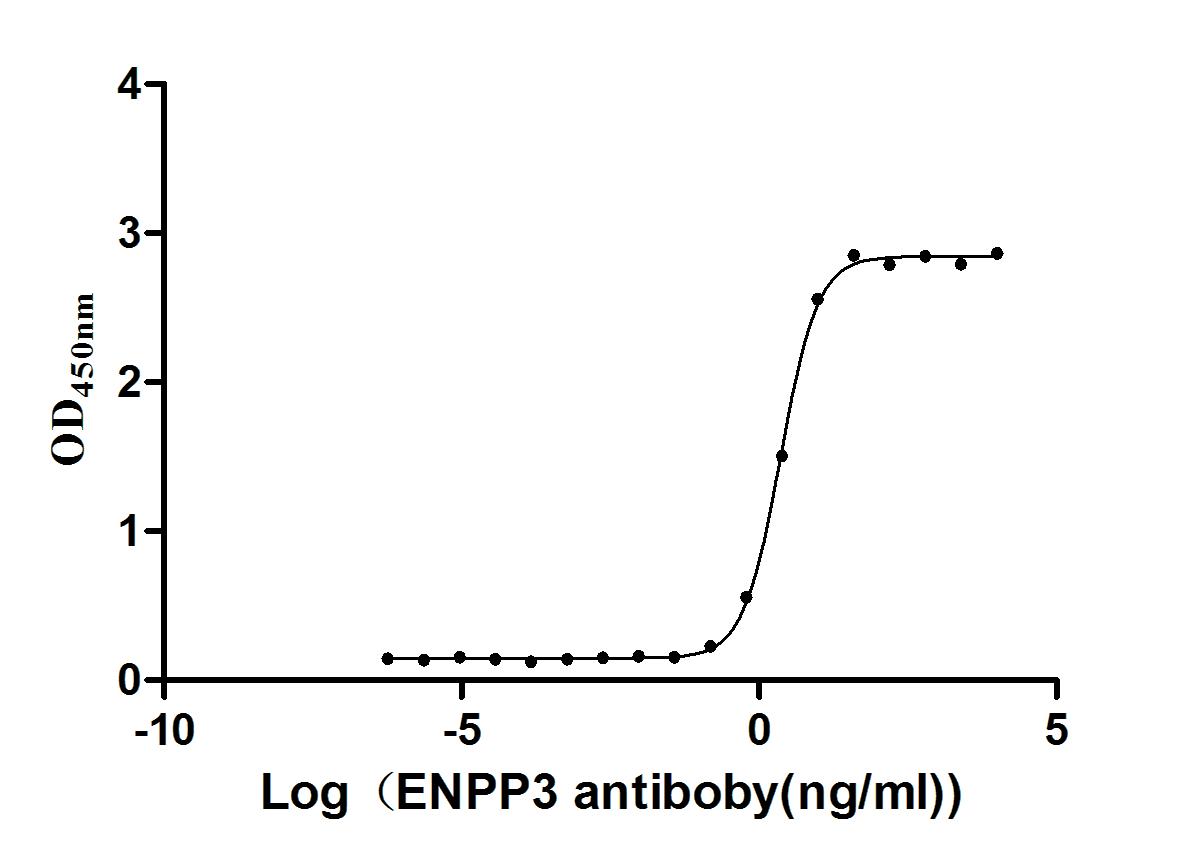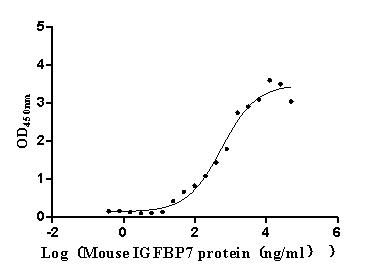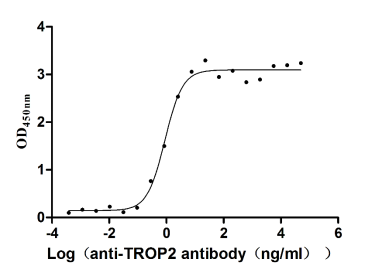Recombinant Human Augurin (ECRG4), partial
In Stock-
中文名稱:人ECRG4重組蛋白
-
貨號(hào):CSB-EP887957HU
-
規(guī)格:¥1836
-
圖片:
-
其他:
產(chǎn)品詳情
-
純度:Greater than 85% as determined by SDS-PAGE.
-
生物活性:Not Test
-
基因名:ECRG4
-
Uniprot No.:
-
別名:(Esophageal cancer-related gene 4 protein)(ECRG4)
-
種屬:Homo sapiens (Human)
-
蛋白長(zhǎng)度:Partial
-
來源:E.coli
-
分子量:12.9 kDa
-
表達(dá)區(qū)域:71-132aa
-
氨基酸序列QLWDRTRPEVQQWYQQFLYMGFDEAKFEDDITYWLNRDRNGHEYYGDYYQRHYDEDSAIGPR
Note: The complete sequence including tag sequence, target protein sequence and linker sequence could be provided upon request. -
蛋白標(biāo)簽:N-terminal 10xHis-tagged and C-terminal Myc-tagged
-
產(chǎn)品提供形式:Liquid or Lyophilized powder
Note: We will preferentially ship the format that we have in stock, however, if you have any special requirement for the format, please remark your requirement when placing the order, we will prepare according to your demand. -
緩沖液:If the delivery form is liquid, the default storage buffer is Tris/PBS-based buffer, 5%-50% glycerol. If the delivery form is lyophilized powder, the buffer before lyophilization is Tris/PBS-based buffer, 6% Trehalose.
-
復(fù)溶:We recommend that this vial be briefly centrifuged prior to opening to bring the contents to the bottom. Please reconstitute protein in deionized sterile water to a concentration of 0.1-1.0 mg/mL.We recommend to add 5-50% of glycerol (final concentration) and aliquot for long-term storage at -20℃/-80℃. Our default final concentration of glycerol is 50%. Customers could use it as reference.
-
儲(chǔ)存條件:Store at -20°C/-80°C upon receipt, aliquoting is necessary for mutiple use. Avoid repeated freeze-thaw cycles.
-
保質(zhì)期:The shelf life is related to many factors, storage state, buffer ingredients, storage temperature and the stability of the protein itself.
Generally, the shelf life of liquid form is 6 months at -20°C/-80°C. The shelf life of lyophilized form is 12 months at -20°C/-80°C. -
貨期:3-7 business days
-
注意事項(xiàng):Repeated freezing and thawing is not recommended. Store working aliquots at 4℃ for up to one week.
-
Datasheet & COA:Please contact us to get it.
相關(guān)產(chǎn)品
靶點(diǎn)詳情
-
功能:Probable hormone that may attenuate cell proliferation and induce senescence of oligodendrocyte and neural precursor cells in the central nervous system. ECRG4-induced senescence is characterized by G1 arrest, RB1 dephosphorylation and accelerated CCND1 and CCND3 proteasomal degradation.
-
基因功能參考文獻(xiàn):
- we have provided evidence to show that Ecrg4 is constitutively expressed in atria and the conduction systems and is down-regulated in AF. PMID: 28578429
- mutations in Pakistani patients with dilated cardiomyopathy rs375563861 (C2orf40), rs143187236 (MYOM3), and rs564181443 (RTKN2) have 3 fold or higher allele frequency in South Asians than in the global populations PMID: 29886034
- ECRG4 down-regulates UBE2C expression in esophageal squamous cell carcinoma cells. PMID: 29268240
- Results from many studies support the discovery that ECRG4 plays a critical role in the pathogenesis of atrial fibrillation. [review] PMID: 29126922
- UBR5 directly binds to the tumor suppressor esophageal cancer-related gene 4, increasing its ubiquitination to reducing the protein stability of ECRG4 to promote colorectal cancer progression. PMID: 28856538
- positive and negative regulatory elements controlling ECRG4 expression include a counter regulation between promoter methylation and Sp1 activation. PMID: 28870864
- the overexpression of Beclin 1 promoted apoptosis and decreased invasion by upregulating the expression of ECRG4 in A549 lung adenocarcinoma cells. Therefore, the selection of Beclin l as a target for gene therapy represents a more effective method for the treatment of lung cancer. PMID: 27175789
- Downregulated ECRG4 is correlated with lymph node metastasis in nasopharyngeal carcinoma PMID: 27119734
- The overexpression of ECRG4 inhibited tumorigenesis. PMID: 26762416
- ECRG4 may be a tumor suppressor in renal cancer and serve as a prognostic marker PMID: 26276361
- low expression or no expression of ECRG4 in esophageal cancer tissues was closely related to the degree of tumor invasion level, TNM staging, lymph node metastasis and recurrence and survival after surgery. PMID: 26823803
- loss of ECRG4 protein expression may be involved in tumor progression and may serve as a prognostic biomarker for breast cancer. PMID: 26631111
- Overexpression of ECRG4 inhibited laryngeal cancer cell proliferation and induced cancer cell apoptosis. PMID: 26165988
- Our data suggest that methylation-mediated suppression of the ECRG4 gene occurs frequently in nasopharyngeal carcinoma PMID: 25707757
- Results identify Ecrg4 as a paracrine factor that activates microglia and is chemotactic for monocytes, with potential as an antitumor therapeutic. PMID: 25378632
- ECRG4 is present on the surface of human monocytes and granulocytes and its interaction with the innate immunity receptor complex supports a role for cell surface activation of ECRG4 during inflammation PMID: 25511108
- The expression of ECRG4 is frequently upregulated in a papillary thyroid carcinoma through the demethylation mechanism of CpG islands in the gene promoter region, and the ECRG4 has a tumor-promoting function through inducing the cell cycle transition PMID: 25326809
- ECRG4 is a candidate tumor suppressor gene that might be involved in the proliferation of esophageal squamous cell carcinoma PMID: 23957914
- results suggest that C2ORF40 acts as a tumor suppressor gene in breast cancer pathogenesis and progression and is a candidate prognostic marker for this disease PMID: 23770814
- overexpression of ECRG4 enhanced the chemosensitivity of gastric cancer SGC-7901 cells to 5-FU through induction of apoptosis. PMID: 23553029
- Aberrant DNA methylation of ECRG4 gene is associated with colorectal cancer. PMID: 22901147
- Aberrant ECRG4 promoter methylation may be used to monitor early gastric cancer and predict pathological staging. PMID: 22626786
- DNA methylation of the ECRG4 promoter causes loss of ECRG4 gene expression in the esophageal squamous cell carcinoma cell line EC9706. PMID: 22325214
- kDa Ecrg4 localizes to the cell surface of prostate (PC3) or kidney (HEK) epithelial cells after transfection. PMID: 22526622
- Tumor necrosis factor-alpha-induced apoptosis was also suppressed in ECRG4-overexpressing Jurkat cells. PMID: 22411956
- ECRG4 is a candidate tumor suppressor gene in breast cancer PMID: 22110708
- Augurin would play a constitutive inhibitory function in normal CNS while down regulation of Ecrg4 gene expression in injury, like in cancer, dysinhibits proliferation. PMID: 21935431
- Data show that ECRG4 interacts directly with ECRG1 to upregulate p21 protein expression, induce cell cycle G1 phase block and inhibit cancer cells proliferation in ESCC. PMID: 21288367
- Loss of ECRG4 is associated with glioma. PMID: 20598162
- ECRG4 is silenced via promoter hypermethylation in different types of human cancer cells. PMID: 20017917
- Inactivation of ECRG 4 gene by hypermethylation is a frequent molecular event in esophageal squamous cell carcinoma and may be involved in the carcinogenesis of this cancer. PMID: 12800218
- Significantly lower expression of esophageal cancer-related gene 4 is associated with esophageal squamous cell carcinoma PMID: 17786363
- The restoration of ECRG4 expression in ESCC cells inhibited cell proliferation, colony formation, cell cycle progression and tumor growth in vivo. ECRG4 is a novel candidate tumor suppressor gene in ESCC. PMID: 19521989
顯示更多
收起更多
-
亞細(xì)胞定位:Secreted. Cytoplasm. Apical cell membrane.
-
蛋白家族:Augurin family
-
組織特異性:Expressed in the brain, with expression in the epithelial cell layer of the choroid plexus (at protein level).
-
數(shù)據(jù)庫鏈接:
Most popular with customers
-
Express system: Mammalian cell
Species: Homo sapiens (Human)
-
Recombinant Mouse Complement component C1q receptor (Cd93), partial (Active)
Express system: Mammalian cell
Species: Mus musculus (Mouse)
-
Recombinant Human Tumor-associated calcium signal transducer 2 (TACSTD2), partial (Active)
Express system: Mammalian cell
Species: Homo sapiens (Human)
-
Recombinant Macaca fascicularis zymogen granule protein 16 homolog B (ZG16B) (Active)
Express system: Mammalian cell
Species: Macaca fascicularis (Crab-eating macaque) (Cynomolgus monkey)
-
Recombinant Human CD81 antigen (CD81), partial (Active)
Express system: Mammalian cell
Species: Homo sapiens (Human)


















